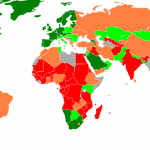How does the monsoon affect the economy?
- Earlier this year, the India Meteorological Department (IMD) had predicted the country would get normal monsoon rains in 2017. The state-run weather body last week said India’s annual monsoon rainfall is expected to be 98% of the long-period average (LPA), up from 96% projected earlier, raising prospects of higher farm output and economic growth.
- The forecast has a margin error of 4%. The monsoon is considered normal if rains in the June-September season are between 96% and 104% of a 50-year average of 89 cm.
Also read: All you need to know about India’s longest river bridge
Why are monsoon rains important for India?
- These rains are the lifeblood of India’s farm-dependent $2 trillion economy, as at least half the farmlands are rain-fed.
- The country gets about 70% of annual rainfall in the June-September monsoon season, making it crucial for an estimated 263 million farmers.
- About 800 million people live in villages and depend on agriculture, which accounts for about 15% of India’s gross domestic product (GDP) and a failed season can have a rippling effect on the country’s growth and economy.
- Whereas, a normal to above-normal and well-distributed monsoon boosts farm output and farmers’ income, thereby increasing the demand for consumer and automotive products in rural markets.
What were recent trends?
- India witnessed a normal monsoon in 2016 but only after two back-to-back poor monsoons in 2014 and 2015 that affected the overall growth in the country.
- However, with a good chance of a normal monsoon in 2017, analysts expect the growth momentum to continue.
- “The second consecutive year of normal monsoon will help revive consumption demand, which was severely affected by the demonetization.”
What happens in the case of a poor monsoon?
- It has a direct impact on the country’s agricultural GDP. The planting of key Kharif, or summer, crops like rice, sugarcane, pulses and oilseeds begins with the arrival of monsoon rains in June.
- Summer crops account for almost half of India’s food output and a delayed or poor monsoon means supply issues and acceleration in food inflation, a key metric which influences Reserve Bank of India’s decision on interest rates.
- A deficit monsoon could also lead to a drought-like situation, thereby affecting the rural household incomes, consumption, and economic growth.
- A poor one not only leads to weak demand for fast-moving consumer goods, two-wheelers, tractors and rural housing sectors but also increases the imports of essential food staples and forces the government to take measures like farm loan waivers, thereby putting pressure on finances.
- Whereas a normal one results in a good harvest, which in turn lifts rural incomes and boosts spending on consumer goods.
- It also has a positive impact on hydropower projects.
What is the current forecast for rain distribution?
- The monsoon rains arrive on the southern tip of Kerala by around June 1 and gradually covers a major part of the country by mid-July before retreating by the end of September.
- The IMD has predicted seasonal rainfall this year to be 96% of LPA over northwest India, and 100% of LPA over Central India.
- Rains in the southern regions are likely to be 99% of LPA while precipitation in north-east India will be 96% of LPA in the four-month period. All projections have a margin error of 8%.
- Rainfall in July and August, crucial months for crop sowing, over the country is expected to be 96% and 99% of LPA, respectively, both with a margin error of 9%. India Ratings said the spread of monsoon over space and time is also forecast to be normal and that bodes well for agricultural output.
- “Even the water storage available in 91 major reservoirs of the country for the week ending on 1 June 2017 was higher than last year by 128% and 105% of the last 10 years, which augurs well for Kharif sowing,” it noted.
Note: Want to share this story with someone? Just click on the icons below.











